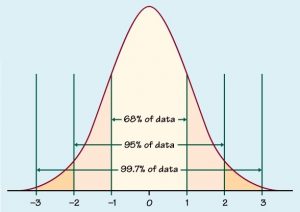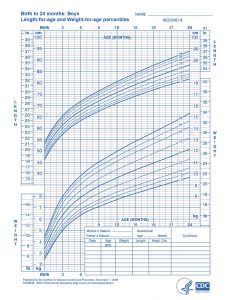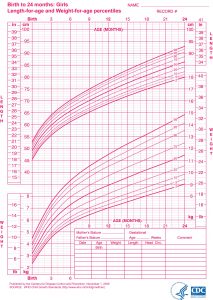Is my baby growing well? Is it okay if my baby’s weight is on a different percentile to his height? Is it normal that my two year old doesn’t seem to have grown at all in the past 3 months? Growth charts really seem to induce a significant amount of confusion and anxiety amongst parents- especially first time parents of young babies.
Statistics:
Let’s start with a basic introduction to statistics, so that we can understand what growth charts are all about. Weight and height follow a pattern of normal, or “Gaussian” distribution. This means that the mean and the median are the same. For those of you who are now feeling that school math was a very long time ago, here are a couple of examples to refresh your memory:
Mean: imagine you add up all the weights of the 30 children in your child’s class and then divide this number by 30- this gives you the “mean” average weight of the children in your child’s class.
Median: imagine you take those same 30 children and line them up in order of their weight from smallest to largest. The middle child has the “median” average weight of the class.
Displayed in graphical form, it looks like this:

Gaussian distribution
As you can see, the centre point, or zero, is where the mean and the median lie. Most of the children in the class will fall into the yellow zone between the -1 and the +1, and would be regarded as having an average weight. These children would fall roughly between the 25th and the 75th centiles on the standard growth charts. Then you have the “normal” children; these children fall into the peach coloured zone between the -2 and the +2; their weight may be regarded as slightly below or above the average, but still normal. These children would have weights between the 10th and 90th centiles on the growth charts.
Finally, there are the children whose weights fall more than 2 standard deviations away from the mean (in the orange zone, between -2 and -3, and +2 and +3). These are the children that may have issues with being under- or overweight. I say “may” because some of these children will be perfectly healthy and it is genetically appropriate that they are in those zones. That is why it is important to look at the child’s height, as well as the height and weight of the parents before making a considered judgement about whether the child may have a growth problem.
What Influences Growth?
Growth is influenced by many different factors at different stages in a child’s life. It’s useful to have a basic understanding of these factors so that we can identify when and if a child has a growth problem.
Prenatal Growth:
In the womb, growth is influenced mainly by the ability of the placenta to provide nutrition. If the placenta is small, or affected by maternal illness such as high blood pressure, diabetes or pre-eclampsia, then the baby may not grow as well as he should. Small sized or obstructed wombs (secondary to fibroids, etc.) can also affect growth. Occasionally, an illness in the baby can result in a smaller size than expected.
Sometimes the placenta can provide “too much” nutrition; this can occur in diabetes or in situations where the placenta and maternal nutrition are working almost too efficiently. This can result in a baby who is unusually “large for gestational age”. Many of these babies drop one or two centiles after birth to follow the centile that is more similar to their genetic potential. This should not be regarded as failure to thrive if the child is otherwise well.
Early Infancy:

Early Infancy Growth
Growth in this period is mostly influenced by nutrition. However there are other factors, such as genetic potential, which may influence growth. Some babies shift onto a new centile after birth if the one at birth was inappropriately high or low based on their long term growth potential.
Babies generally lose up to 10% of their birth weight in the first 5 days of life. Most of this is “water-weight”; babies classically regain this weight by around day 7-10 of life. Thus a baby with a birth weight of 3kg may lose up to 300g to drop to a weight of 2.7kg by around day 5 of life; he should be back to 3kg by around day 7-10 of life. A baby who loses more than 10% of his birth weight, or who takes longer than 14 days to regain his birth weight should be seen by a doctor or health visitor to see whether there is a problem with feeding.
Once a baby has regained his birth weight, he should gain around 30g per day, or 200g per week for the first several weeks.
Theory of Fetal Imprinting:
This is something I find hardly any parent knows about- but it’s crucially important. Studies show that babies who have poor nutrition in the womb but then gain weight rapidly in early infancy (rapid “catch-up”) are at risk of developing metabolic diseases. These include type II diabetes, heart disease and high blood pressure from as young as mid-teens to early twenties. This phenomenon is thought to be due to “down-regulating” of blood pressure and insulin receptors in the womb; these are then inadequate to handle the large quantities of nutrition forced on them in early infancy- often by well- meaning relatives wanting to “fatten them up”.
How can we avoid this risk of metabolic disease? We should aim to allow a baby to gradually catch up their weight over a period of several months. For example, a baby born with a weight on the 3rd percentile should hit the 25th percentile sometime in the second 12 months of life- not the first 3-6 months of life.
Late Infancy and Early Childhood:
Nutrition continues to be an important factor in growth in late infancy and early childhood; decisions made in this period impact on eating choices for the rest of a child’s life. As a child becomes more and more active, it often becomes harder for parents to keep up with nutritional demands; additionally, some children can develop fussy eating habits. See Top Tips For Feeding Toddlers and Getting Your Toddler To Eat Vegetables for further information.
Children who drop two or more centile lines or who have two consecutive weight readings below the 3rd centile may be at risk of faltering growth. Such children would benefit from further assessment by a doctor or health visitor.
Dieticians are valuable resources to help parents increase the energy and nutrition density of their child’s food. Dieticians don’t just teach parents how to hide vegetables!
Some children start to eat too much, or too much of the wrong foods from this age onwards. Studies show that childhood obesity at the age of four years is a strong positive predictor of adult obesity. For advice on combatting childhood obesity, see Childhood Obesity: Is My Child Too Big?
Conclusions:
Although growth charts are useful in tracking a child’s growth, they are not the only indicator of good health. Trends are more useful than individual weight measurements; if you are seeking a medical opinion on your child’s weight remember to take along previous weight and height measurements.
Remember that if you and your partner are both short, you are unlikely to have given birth to a basketball player! Similarly, tall and slim parents often have tall and slim children; children don’t always have to be on the same centile for height and weight.
Indicators of good growth are:
- Roughly following a centile curve: some plateaus and growth spurts are inevitable, but falling past two centile lines on two consecutive visits may require closer attention.
- Steady catch up growth for children born below the 3rd centile: not too rapid, but some improvement across the centiles should be seen.
- Weight and height both increasing steadily; they don’t have to be the same, but steady improvement is appropriate.
Approximately one in 20 children will have a weight below the 3rd centile at some point or another. Around one in one hundred will have more than one consecutive weight below the 3rd centile. However, less than 5% of these children will be suffering with any medical disease. Seek appropriate help, make appropriate interventions- but try not to panic too much!
Please leave your comments and questions in the box. As always, if you found this post useful, and would like to receive similar content, don’t forget to subscribe- leave your email address in the subscriptions box and I will do the rest!



Leave A Reply